Previous Beekeeping Programme (operated from 2003-2008)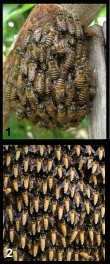 ALL PHOTOS BY DANIEL R. JUMP / ACCB ALL PHOTOS BY DANIEL R. JUMP / ACCB
From 2003 to 2008, ACCB carried out a comprehensive beekeeping and sustainable honey harvesting programme. The bee project, one of the first of its kind in Cambodia, was mainly funded by the Deutsche Gesellschaft für Technische Zusammenarbeit (GTZ).
The project was designed to promote and disseminate instruction on appropriate technology beekeeping with the Asian Hive Honeybee (Apis cerana, photo 1), rafter beekeeping with the Giant Asian Honeybee (Apis dorsata, photo 2), sustainable honey harvesting involving all local honeybee species, adequate honey and wax processing, as well as quality control and marketing of the products. For ecological reasons, the bee programme solely worked with local stocks of native bees and disapproved the importation or use of the exotic European Honeybee Apis mellifera.
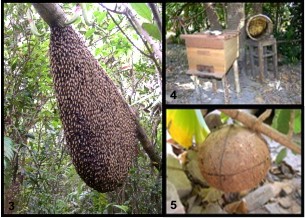 Initially, the bee programme¹s target area comprised four villages in Banteay Srey District in Siem Reap Province, where the beneficiaries were Community Forestry members. Later during the project, our bee team also worked in a number of other provinces including Kompong Chhnang, Koh Kong, Pursat, Banteay Meanchey and Preah Vihear, often in collaboration with other NGOs. Initially, the bee programme¹s target area comprised four villages in Banteay Srey District in Siem Reap Province, where the beneficiaries were Community Forestry members. Later during the project, our bee team also worked in a number of other provinces including Kompong Chhnang, Koh Kong, Pursat, Banteay Meanchey and Preah Vihear, often in collaboration with other NGOs.
ACCB developed specific training courses aimed at traditional honey-hunters and rafter beekeepers, marginal families motivated to try something different, farmers and fishermen willing to learn more about the natural resource they opportunistically exploit, and local middlemen involved in the honey and wax trade. Training sessions covered modules such as basic bee biology and the ecological role of bees, methods of attracting honeybees, colony transfers (e.g. using queen cages and swarm traps) and hive construction, box and rafter beekeeping, pests and diseases, floral resources and calendars, appropriate processing and marketing of honey and bee by-products, as well as species-specific training depending on the bee species found in a given area and their local migration patterns.
Pictures show a rafter with a Giant Asian Honeybee colony (photo 3), a top bar hive and swarm basket for Asian Hive Honeybees (photo 4) and a coconut shell used for stingless Trigona species (photo 5).
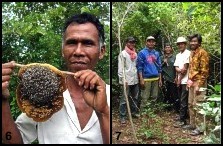 The programme worked largely on the basis of using locally available materials and simple technology that can be replicated by many, at little or no cost to the individuals involved, and putting special emphasis on hands-on, practical training (photo 6 and 7). On photo 6 a bamboo clip with a colony of Dwarf Honeybee (Apis florea) is shown. The programme worked largely on the basis of using locally available materials and simple technology that can be replicated by many, at little or no cost to the individuals involved, and putting special emphasis on hands-on, practical training (photo 6 and 7). On photo 6 a bamboo clip with a colony of Dwarf Honeybee (Apis florea) is shown.
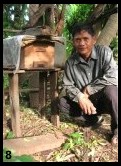 In Cambodia, there is no tradition of keeping the Asian Hive Honeybee, and ACCB was the first organisation to introduce this technique. These bees produce comparatively little honey and wax, enough for occasional personal consumption but not enough for large scale marketing. However, they provide invaluable benefits due to their pollination activity, thereby for example considerably increasing the harvest of local fruit trees. In Cambodia, there is no tradition of keeping the Asian Hive Honeybee, and ACCB was the first organisation to introduce this technique. These bees produce comparatively little honey and wax, enough for occasional personal consumption but not enough for large scale marketing. However, they provide invaluable benefits due to their pollination activity, thereby for example considerably increasing the harvest of local fruit trees.
Photo 8 shows the box beekeeping of the Asian Hive Honeybee.
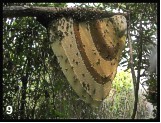 In a tradition that goes back many generations, subsistence farmers in Tbeng Commune (Banteay Srey District) in north-western Cambodia induce colonies of Giant Asian Honeybees to settle low to the ground, by placing in strategic locations long poles (so-called ¹rafters¹) at an angle of around 30 degrees, on which the bees can build their comb (photo 9). Normally, these bees settle on the branches of tall forest trees. In a tradition that goes back many generations, subsistence farmers in Tbeng Commune (Banteay Srey District) in north-western Cambodia induce colonies of Giant Asian Honeybees to settle low to the ground, by placing in strategic locations long poles (so-called ¹rafters¹) at an angle of around 30 degrees, on which the bees can build their comb (photo 9). Normally, these bees settle on the branches of tall forest trees.
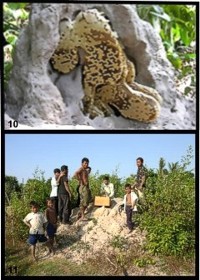 The absence of weaver ants is of paramount importance when determining the location for rafters, while the direction of the sun plays no role. Rafters are usually well-protected by the surrounding vegetation on all but one side. The resulting opening at the upper end of the rafter serves as flight path for the bees. Once a swarm settles on a rafter, this rafter tends to get occupied year after year. Therefore, the rafters are not removed at the end of harvest season, but simply replaced every three years. The absence of weaver ants is of paramount importance when determining the location for rafters, while the direction of the sun plays no role. Rafters are usually well-protected by the surrounding vegetation on all but one side. The resulting opening at the upper end of the rafter serves as flight path for the bees. Once a swarm settles on a rafter, this rafter tends to get occupied year after year. Therefore, the rafters are not removed at the end of harvest season, but simply replaced every three years.
Photo 10, 11 and 12 show a feral colony transfer of Asian Hive Honeybee
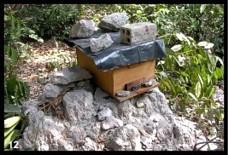 Rafter beekeeping is a seasonal activity. For example, in Banteay Srey district the bees begin to settle on the rafters during the early dry season in October and November, when they migrate from higher elevations of the Kulen mountain range down into the lowlands. The main honey harvesting period is towards the end of the dry season in March and April. Rafter beekeeping is a seasonal activity. For example, in Banteay Srey district the bees begin to settle on the rafters during the early dry season in October and November, when they migrate from higher elevations of the Kulen mountain range down into the lowlands. The main honey harvesting period is towards the end of the dry season in March and April.
ACCB started working with the rafter beekeepers in Tbeng in 2004, mainly promoting sustainable honey harvesting, and assisting with quality control and the marketing of their honey. Furthermore, one experienced rafter beekeeper was employed by the bee programme to help spreading the knowledge of this technique to other areas and regions.
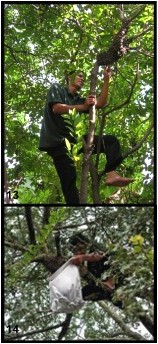 Wild honey produced by the Giant Asian Honeybee is traditionally harvested in all forested parts of Cambodia. Good quality dry season honey (which contains less moisture and can be stored for longer periods than wet season honey) can fetch a high price, and honey collection provides livelihoods for many rural people. Traditional honey hunters and middlemen involved in the trade often largely depend on the money generated from the sale of honey, and many subsistence farmers and fishermen collect honey opportunistically or as an additional source of income. However, in many areas of Cambodia the high rate of forest loss and the subsequent disappearance of bees is making this activity more and more unprofitable. Wild honey produced by the Giant Asian Honeybee is traditionally harvested in all forested parts of Cambodia. Good quality dry season honey (which contains less moisture and can be stored for longer periods than wet season honey) can fetch a high price, and honey collection provides livelihoods for many rural people. Traditional honey hunters and middlemen involved in the trade often largely depend on the money generated from the sale of honey, and many subsistence farmers and fishermen collect honey opportunistically or as an additional source of income. However, in many areas of Cambodia the high rate of forest loss and the subsequent disappearance of bees is making this activity more and more unprofitable.
Early in the season honey hunters search the forest for bee colonies and mark occupied trees, so that other honey collectors can see that the colony is already ‘taken’. Later they return to harvest the honey. The harvesting season varies across the country. For example, on the Tonle Sap Great Lake honey is harvested during the rainy season when the floodwaters allow access to the flooded forests. Honey hunters are adept at climbing and can reach even the seemingly most inaccessible colonies high up in the outer branches of tall trees.
Photo 13 and 14 show swarm capture of Asian Hive Honeybee.
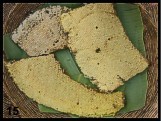 Traditionally, the honey is harvested in a non-sustainable way, on a one-cut-take-all basis, where the entire comb is cut off, the honey is squeezed out and the larvae are sold to be cooked and consumed. The bees lose their offspring and if the colonies survive, they subsequently leave the area. However, to avoid being stung often the bees are killed using insecticides or by lighting a fire under the tree at night. Unless the queen survives, not only the larvae, but the entire bee colony is lost and dies. Traditionally, the honey is harvested in a non-sustainable way, on a one-cut-take-all basis, where the entire comb is cut off, the honey is squeezed out and the larvae are sold to be cooked and consumed. The bees lose their offspring and if the colonies survive, they subsequently leave the area. However, to avoid being stung often the bees are killed using insecticides or by lighting a fire under the tree at night. Unless the queen survives, not only the larvae, but the entire bee colony is lost and dies.
Rafter beekeepers traditionally also harvest their colonies in a non-sustainable way, but they use smoke to deter the bees and therefore do not usually kill the entire colony (photo 15).
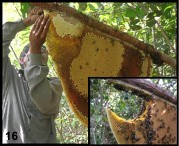 The ACCB bee programme has been working with rafter beekeepers and traditional honey hunters to promote sustainable honey harvesting. During a sustainable harvest only the so-called ‘honey head’ is removed, an area at the upper end of the comb that contains almost all the honey (photo 16). The rest of the comb is left intact, and the bees soon replace the honey head. This technique allows for earlier and multiple harvests, and also helps to protect the bees and restore their population in a given area. Having been deterred by smoke, within minutes after the sustainable harvest the bees are back on their comb. Once the bees start to migrate, the empty and abandoned comb is removed and processed to wax for sale. The bees return to the same place in the next season. The ACCB bee programme has been working with rafter beekeepers and traditional honey hunters to promote sustainable honey harvesting. During a sustainable harvest only the so-called ‘honey head’ is removed, an area at the upper end of the comb that contains almost all the honey (photo 16). The rest of the comb is left intact, and the bees soon replace the honey head. This technique allows for earlier and multiple harvests, and also helps to protect the bees and restore their population in a given area. Having been deterred by smoke, within minutes after the sustainable harvest the bees are back on their comb. Once the bees start to migrate, the empty and abandoned comb is removed and processed to wax for sale. The bees return to the same place in the next season.
|



